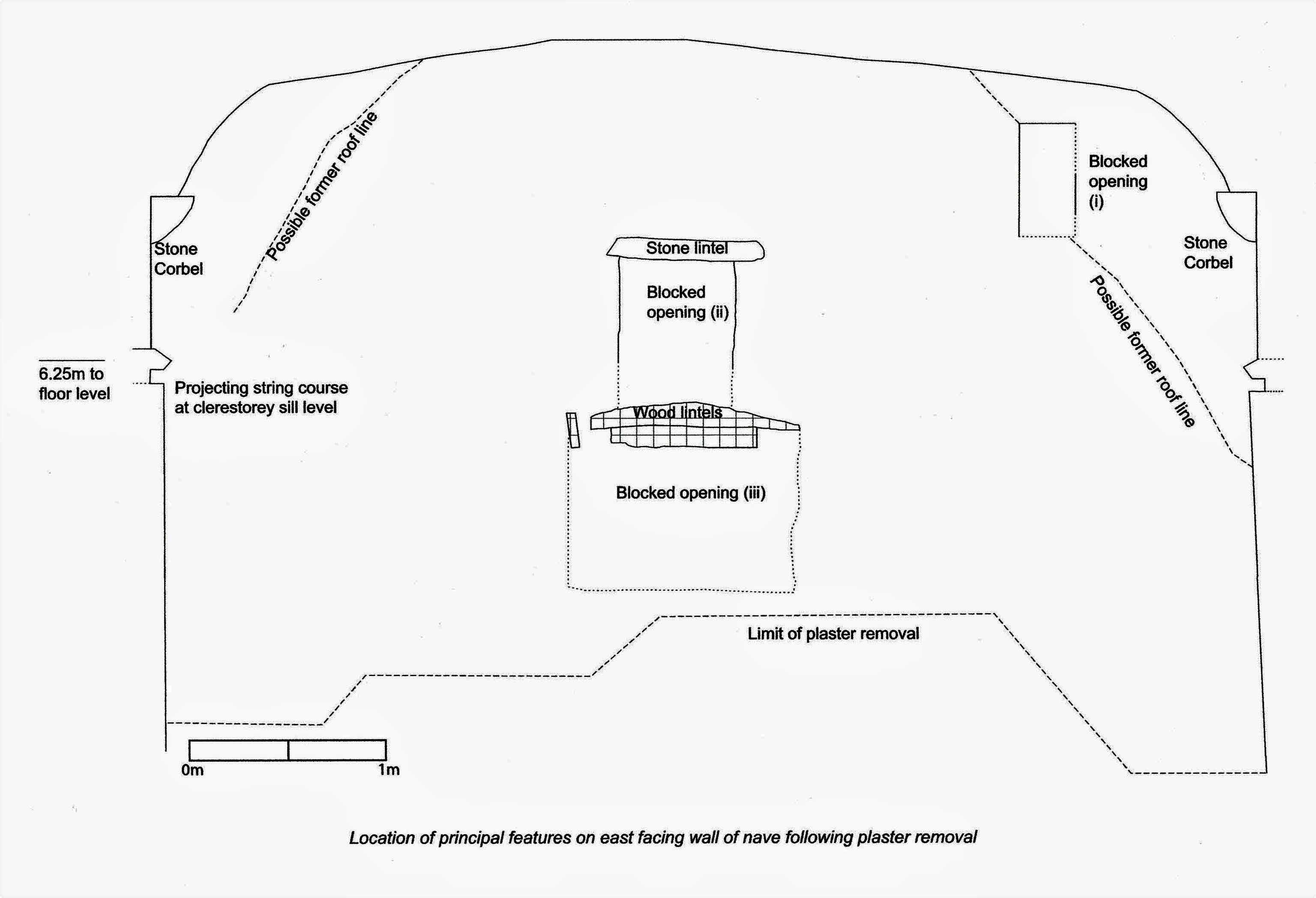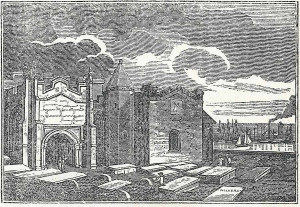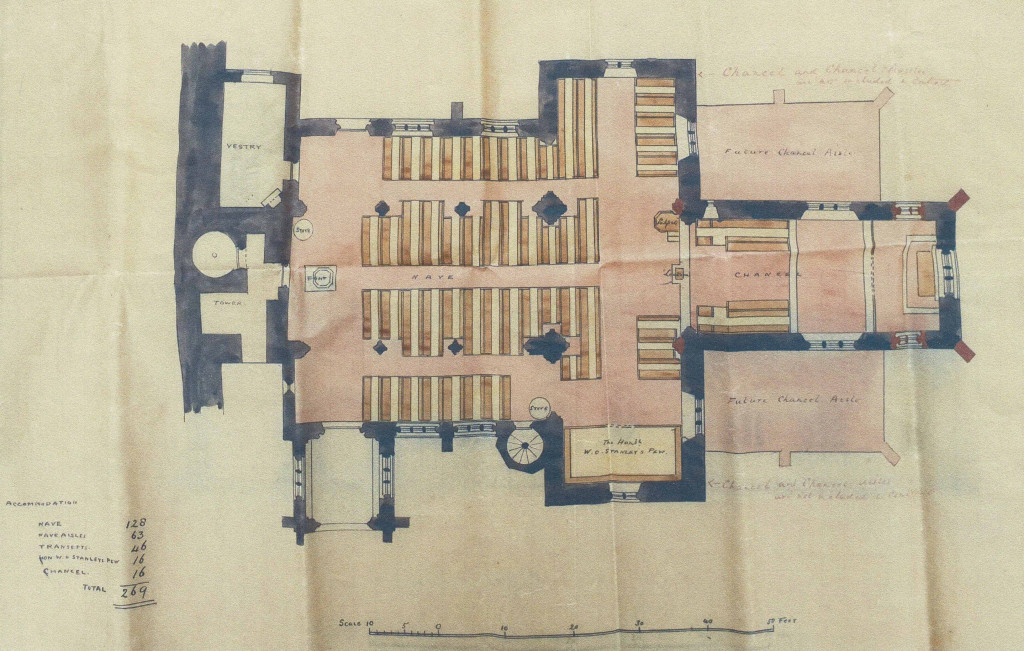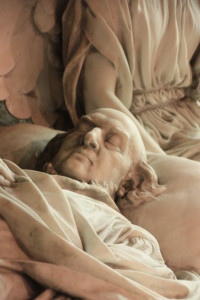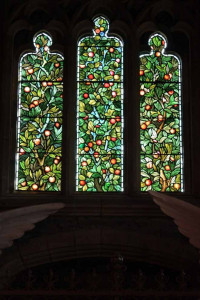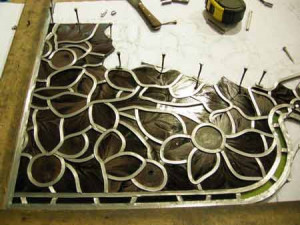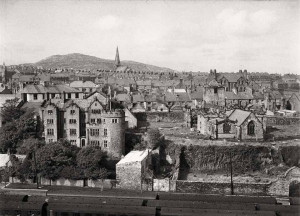Change and extension
Lucy Williams indicates “In 1816. with Captains Skinner and Davies as Wardens, two new galleries, a new pulpit and reading desk were installed at St Cybi’s, and some additions to the high pews allocated to the properties of the parish. Perhaps it was at this time that the fourteen ancient carved prebends’ stalls, and the old sea-quadrant noted by Pennant, were removed. and it is evident from a protesting letter of Lady Stanley, that the improvements were incongruous. They were removed at the restoration by Sir Gilbert Scott [1877-9].”[i]
During restoration work in 2013 plaster was removed from the west wall of the nave and the exposed stonework revealed evidence of some previous alterations. These were recorded by Gwynedd Archaeological Trust who concluded the two diagonal lines are best interpreted as marking a former pitched roof-line, possibly belonging to the earlier 12thcentury church.
The purpose of the small north opening is unknown, although it may suggest the presence of a former stair, either inside or outside the west wall.
The two larger openings appear, from the style of construction, to be later in date, and to post-date the construction of the tower. The upper opening appears to be the earlier, and may date from the occupation of the church by the military during the civil war. Either might be associated with a west gallery, a feature of many Anglesey churches in the 18th century.
Could this last mentioned opening be evidence of the galleries installed in 1816 as mentioned in Lucy William’s article?
Lady Stanley was not the only one who found these pews and galleries out of keeping. In the January 1863 edition of Archaeologia Cambrensis “H.L.J” as part of a series of articles under the general title of ‘Mona Mediaeva’ comments about the church “The whole of the interior is greatly blocked up and spoiled by high pews and galleries; but if these were replaced by suitable benches, and if the pulpit, etc., were properly treated, the whole would be much improved.”
In her article Lucy Williams says until 1817 the church services were in Welsh morning and evening, except the third Sunday in the month, when the service was in English, but in that year, after strong pressure by the English section of the community, the Rev. Ellis Anwyl Owen commenced an alteration, the Welsh service with sermon being at 10.00 am, and the English at 2.00 pm on the first three Sundays of the month, and on the last the English Sacrament at 11.00 am and the Welsh service at 2.00 pm.
At the start of the 1800’s as part of the development of the harbour there was land reclamation which meant that the shore line was moved away from the base of the cliff. Following this land reclamation on 2ndSeptember 1826 the lower churchyard was consecrated.
In 1841 under the provisions of the Tithe Commutation Act 1836 Tithes were replaced with monetary payments and for each area a map was prepared for assessing the necessary valuation. The map for Holyhead was prepared in 1841 by William Williams and records “Holyhead Church” as owning nine plots of land within the town. These plots were scattered around the town, but all recorded as being part of Bodrewyn Farm. The total area of these plots was 11 acres, 2 Roods and 23 Poles, with an assessed value of £2. 6s. 8d.
The Rectory, then fronting on to what is now Newry Street was recorded as occupied by Rev. John Wynne Jones, consisting of 5 acres and 11 Perches or Poles, and valued at 19s. 2d. There is now a housing estate built over what were the rectory grounds.
On the 13thAugust 1855 there was a direction that burials be discontinued in the cemetery adjoining the parish church. This was varied on 23rd September 1859 with a direction that burials be now wholly discontinued in the Parish Church, in the Cemetery and the additional churchyard ‘except in walled graves now completed to the surface in which a coffin shall be embedded in charcoal and separately entombed in an airtight manner’.
Between 1877 and 1879 there was an extensive restoration of the church by Sir Gilbert Scott, and after his death in 1878 by Arthur Baker, who had joined Sir Gilbert as a pupil between 1864 and 1867 and then stayed as his assistant.
This included work to the North and South arches from the crossings to the transepts and their eastern responds. Chancel North and South walls re-windowed. Stanley Pew installed in South Transept. Old Box pews removed and replaced by open pews with matching lectern, pulpit and choir stalls. Gas lighting installed.
In a report to the church dated 19th June 1876 Sir Gilbert Scott indicated the present chancel roof being in a good state of repair, though of no historical or architectural interest, will be preserved and hidden from view by a new panelled ceiling. The nave will be paved with plain and the chancel with encaustic tiles, preserving all monumental stones in their proper places; and the whole chancel will be refitted with oak seats in character with its architecture.
There is reference to “By the removal of the earth accumulated within the building, the bases of the pillars long buried were brought to light, and the church revealed once more in the beauty of its original proportions”.
Scott’s plans for adding aisles to the chancel were not carried out because it was found, on more careful examination, that the fine oak roof of the Church was much more dilapidated than had been expected which meant the work was going to cost much more than anticipated.
Sir Gilbert Scott was the son of a cleric and grandson of the biblical commentator Thomas Scott. He was a prolific English Gothic revival architect, chiefly associated with the design, building and renovation of churches and cathedrals, although he started his career as a leading designer of workhouses. Over 800 buildings were designed or altered by him.
A new chapel
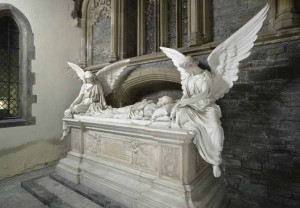
The Stanley monument by Hamo Thornycroft (photo copyright Royal Commission on the Ancient and Historical Monuments of Wales).
In 1897 a chapel was added to the south side of the chancel, including a memorial to William Owen Stanley who had contributed most of the cost of the restoration work carried out between 1876 and 1879 and died in 1894.
Once again Arthur Baker was involved in the work, but he died before the work was complete and it was left to his partner, and son-in-law, Harold Hughes of Bangor to finish the work. The building work was done by Mr. R. Bridgeman of Lichfield.
A contemporary pamphlet gives some detail of the work describing the Stanley Monument as “of Carrara marble, designed by Hamo Thornycroft, R.A. It consists of a life-size recumbent figure with watching angels at the head and the feet. With the help of Mr Watts, R.A., and his knowledge of the original, the sculptor has produced a wonderful likeness, recalling to all who knew him the characteristics of Mr Stanley’s fine head and impressive features.”
The watching angels are intended to represent St Cybi and St Seiriol.
The marble carving is widely considered to be one of the best of the period. In front of the memorial is an iron grill formed entirely of Mrs Stanley’s initials, E. and S. which is the work of Mr T.J. Gawthorp of Long Acre, London.
The chapel was originally called the Stanley Chapel but is now known as St. David’s Chapel.
In some ‘Additional Notes’ to a 1935 pamphlet about the church by H Harold Hughes MA FSA Alfred F Sotheby comments:
“Further mention must be made of the Stanley Chapel on the south side of the church. This, though modern, carries on the spirit of the old church. Successive owners of Penrhos were closely connected with the fortunes of Holyhead. Sir John, afterwards first Lord Stanley of Alderley, his brother Bishop of Norwich, and their sons, the Hon. W. O. Stanley and Arthur Penrhyn Stanley, Dean of Westminster, took much interest in the legends and architecture of the Church. Mrs. Stanley, the wife of the Hon. W. O. Stanley of Penrhos, herself a Welsh-woman, devoted her time and energy to further the good of Holyhead. During the last months of her life she interested herself in the plan to restore S. Cybi’s Church. The work was later carried out under the direction of Sir Gilbert Scott. But Mrs. Stanley’s last wish, that a fitting shrine should be erected to the memory of Mr Stanley, was ultimately brought about after her death by her niece, Jane Henrietta Adeane, who had filled the place of a daughter at Penrhos.
The Chapel in which the monument rests was built by Miss Adeane at her own cost and was dedicated and the monument unveiled in 1897.
Mrs. Stanley’s wish that there should be no monument to herself has been respected, but the wrought-iron work of the screen in the Chapel bears her initials, E and S, intertwined and constantly repeated, an idea suggested by S. Anselm’s Chapel in Canterbury Cathedral.”
The chapel includes three fine windows manufactured by Morris & Co. First, St Michael overcoming the devil with angels; second, St Dorothy, St Theresa and St Agnes, and thirdly The Tree of Life window. This last window depicts foliage and fruits with pomegranates in the left and right lights and apples in the centre light (the pomegranate, packed with seeds, was considered a symbol of the resurrection).
- The tree of life window after restoration and in the workshop during restoration.
In 2009 the Tree of Life window was restored by Recclesia who posted comments about the work on their website saying “The William Morris Tree of Life window in the Stanley Chapel at St Cybi’s Church in Holyhead on Anglesey is a major tourist attraction. Commissioned by a Muslim family for a Christian building, the window is unique in not depicting any characters or animals. Instead, the entire window is given to the Tree of Life or the Jesse Tree, which fills the glass with rich foliage in sumptuous greens and pomegranates in pink and deep orange.”
Further change
With a history of inception as a Clás, followed by a change of influence from the Celtic Church to the Church of Rome, then establishment as a Collegiate Church, followed by the Dissolution and inclusion in the foundling Church of England, the start of the 20thCentury saw yet another new beginning. On 31stMarch 1920 the provisions of the Welsh Church Act 1914 came into effect. This provided for the disestablishment of Welsh churches from the Church of England and the creation of the Church in Wales. For St Cybi’s this meant that control of the church, and the appointment of clergy, passed from Jesus College Oxford to the Diocese of Bangor.
In 1957 thechurch entered into a deed with the local authority under which the Council agreed to maintain the Churchyards which were designated an ‘Open Space’.
The effect of the agreement was for the Council to occupy and maintain the churchyard in trust, for the benefit not only of the church but the whole community, providing a quiet space within the town.
The deed provided for the Council laying flat the gravestones, citing the authority of a Faculty granted as long ago as 1925, which suggests the church was struggling to implement the terms of the Faculty. This suggestion is supported by a contemporary photograph showing the churchyard overgrown with weeds.
In 2014 there was an administrative reorganisation by Bangor Diocese which, in place of numerous Parishes created a much smaller number of ‘Ministry Areas’. St Cybi’s ceased to be part of a Rectorial Benefice and became one of four churches within the Bro Cybi Ministry Area.
The other three churches are St David’s, Morawelon, built in the 1960’s; St Ffraid’s Trearddur Bay, built in 1932, but with a history going back to St Ffraid herself and St Gwenfaen’s, Rhoscolyn where the present church, listed Grade II dates from the 1870’s but, as with St Ffraid’s, a history dating back to the original founding Saint.
The Ministry Area covers the whole of Holy Island, known in Welsh as Ynys Cybi (which translates as Cybi’s Island).
Much work is being done to preserve St Cybi’s church. In 2013 repairs costing £77,000 were carried out and in 2019 there has been further restoration work costing over £250,000 including work cleaning and preserving the important carved stonework.
This latest work has also seen the first substantial alteration to the Church since 1897. The damage caused to the south porch by Cromwell’s troops has been left untouched, despite pleas to do something has now been addressed. In November 1867 the local newspaper commented the porch was “certainly no credit to either dissenters or churchmen. To the former, it detracts from the respect visitors and strangers can have for us as townsmen. Churchmen forsooth, who have to enter it every now and then, may not turn a deaf ear to the lamentable imploration of the “porch, which contains a rude figure of the canopy” to give it a few panes of glass to ward off the coming season, if not for the respect we owe to the memory and the architecture of our ancestors.” Over 150 years later the few panes of glass have been fitted. The work also includes replacing metal gates with glass doors which, together with the new windows, enclose the porch protecting the carvings above the south door from further erosion by the weather.
This work would not be possible without the generous help and support of grant funding. This has included, in 2013, funding from Heritage Lottery Fund, Cadw and Anglesey County Council. In 2019 funding has again been provided by Heritage Lottery Fund together with grants from W. G. Roberts Fund, Garfield Weston Foundation, James Pantyfedwen Foundation, the Allchurches Trust and the Representative Body of the Church in Wales.
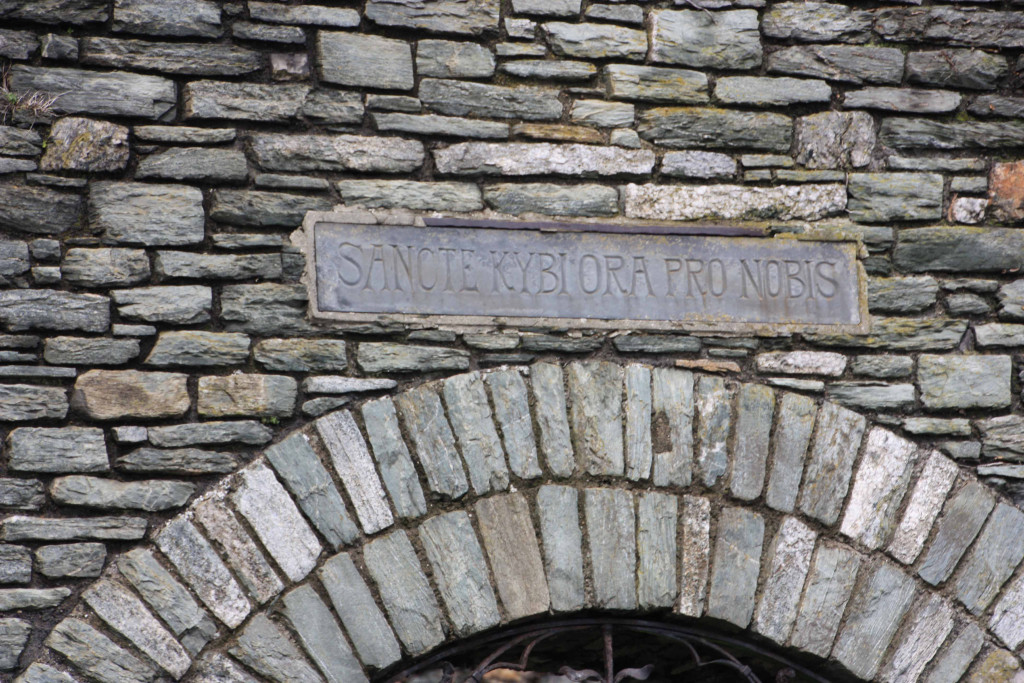
‘Sancte Kybi ora pro nobis.’ – ‘St. Cybi pray for us.’ Inscription above the gate of the lower churchyard
The Ministry Area is very grateful to all our fund providers for enabling us to ensure that St Cybi’s continues to be a place of pilgrimage, prayer, contemplation and reflection for generations to come.
[i]Factors in the culture of pre-railway Holyhead: Transactions of the Anglesey Antiquarian Society, 1940.
